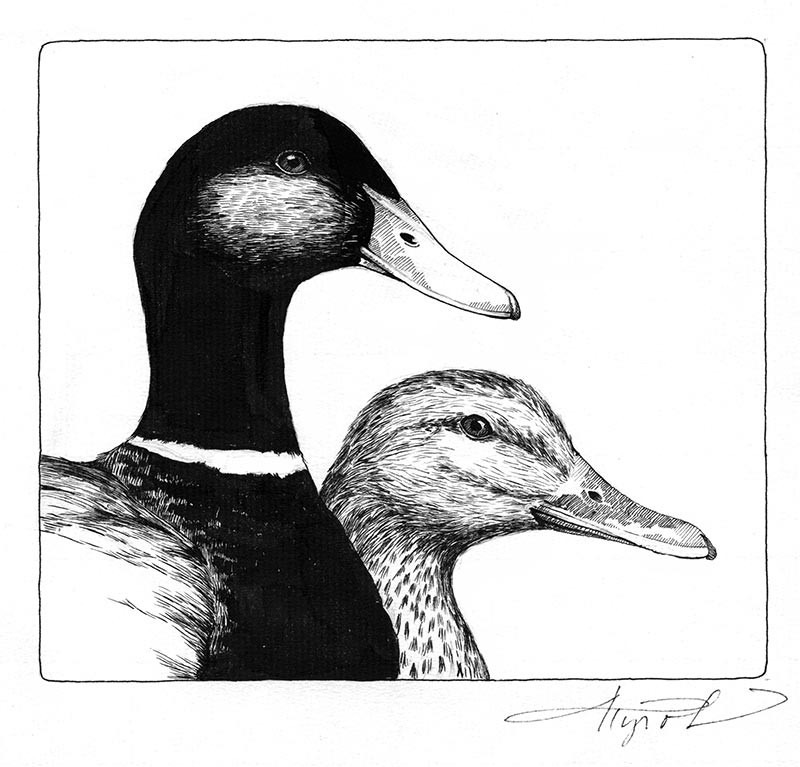
Robert McCloskey’s Make way for Ducklings is one of my favorite childhood books. I loved the way Mr. and Mrs. Mallard interacted, their seemingly endless search for the perfect nesting place, the description of classic Boston neighborhoods, and the whimsical names of their eight ducklings.
Not until I started reading the story to my own children, several years ago now, did I notice Mr. Mallard ditches Mrs. Mallard after the ducklings hatch, leaving her to tend to eight kids on her own, amid the dangers of snapping turtles and Boston traffic.
It turns out Mr. Mallard, with his handsome green head, dapper blue wing patches, and charmingly curled tail can be a bit of a scamp; male mallards will mate with just about any feathered thing that floats on water. And they’re not always nice about it.
Hybridization among different species of ducks is not all that unusual, but mallards are one of the most common hybridizers, crossing with black ducks, mottled ducks, teals, and others, often by forced copulation.
This aggressive, nonselective behavior pays off in the short term, but in the longer term the verdict is still out. While mallards are the most abundant and widespread duck species in North America – with an estimated 11.6 million breeding birds in 2014, according to the U.S. Fish and Wildlife Service – their population has dropped by 29 percent along the Atlantic Coast since 2000 and by 40 percent in New York and Pennsylvania. The reason – or reasons – for that population decline is not clear, but one theory is that wild mallards and farm-raised mallard game birds have mingled in a genetically detrimental manner.
Mallard ducks are not native to the Northeast, although according to Michael Schummer, a biology professor at the State University of New York’s College of Environmental Science and Forestry, it’s not clear whether they arrived on their own, following open space as forests were cleared, or were introduced. Until the 1960s, he said, state-sanctioned programs in the Atlantic Flyway released half a million farm-raised game mallards every year. Private landowners still release around 270,000 game mallards each year on the Atlantic Seaboard.
“Generally, game farm mallards have bills that are more goose-like,” said Schummer, who has co-authored a study on the influence of game bird releases on wild mallard populations. The lamellae – comb-like structures inside the bill used to filter out inedible bits as the ducks feed – are spaced farther apart than in wild mallards. “This makes them more adept at eating large items like pellets or corn than small aquatic food.”
Farm-raised game birds are generally smaller than their wild counterparts. They also differ in the timing of their nest initiation, clutch size, and incubation length.
The hybridization of game farm mallards with wild birds over the past century has affected the wild population, Schummer said, to the point where the eastern population is “on the cusp of becoming a hybrid swarm.” The offspring of wild mallards crossed with game farm ducks have mixed with both their parent types and with each other, exacerbating genetic traits less well-adapted to foraging and surviving in the wild. Game farm mallards may comprise up to 14 percent of breeding mallards in the Atlantic Flyway, and roughly 75 percent of mallards in the eastern U.S. show traits of game farm mallards. As Schummer puts it: “We might have a duck that is really a game farm bird here.”
Schummer said an ever-changing landscape could also be a factor in the decreasing numbers of mallards in the Atlantic Flyway. A focus on restoring wetlands throughout the Northeast in recent years, often on what had been farmland, could be detrimental to a mallard that is more farm-raised than wild. In other words, one better adapted to consuming waste corn than the food available on reclaimed wetlands.
McCloskey wrote Make Way for Ducklings in 1941, but even then, his mallards followed the swan boats around Boston Common eating the peanuts tourists tossed their way. Perhaps, even back then, the game farm ducks and wild ducks were keeping company with each other.

